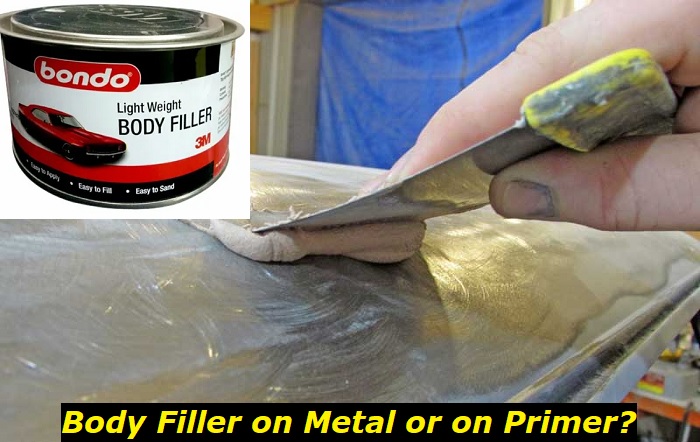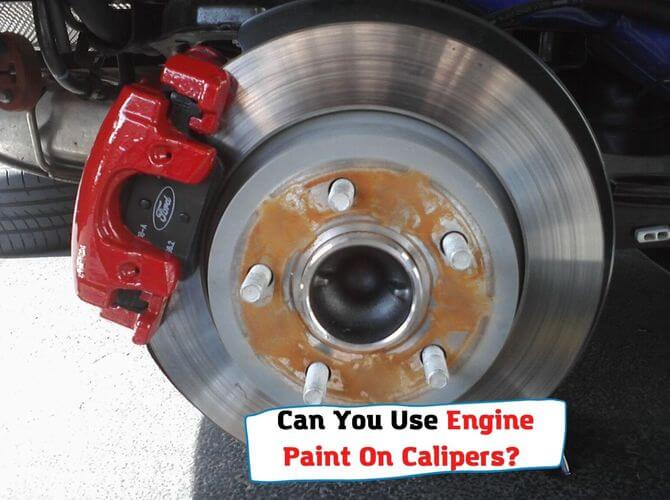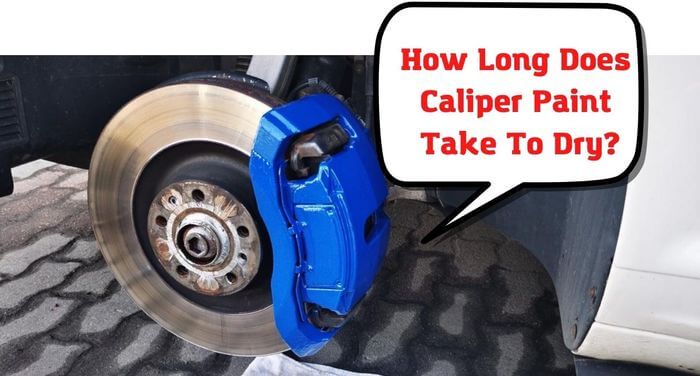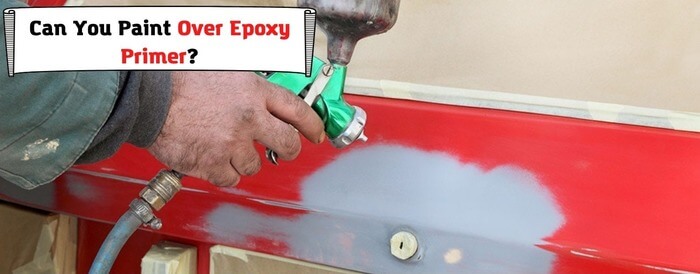While some auto body repair technicians prefer applying body filler on bare metal, others apply primer first. But is it a good idea to use the body filler on bare metal, or do you need to start with a primer first? In this post, we will look at what works well and in what circumstances.

Which Comes First, Primer or Filler?
If you’re looking to repair and paint a car body, it’s best to have the body filler on bare metal and then apply the primer to protect everything underneath.
Although some people apply primer before body filler, the results are disastrous. The filler starts peeling off after a short while.
Usually, when you apply primer on bare metal, the body filler will not bond well. The body filler will likely peel off quicker than if you apply it on bare metal.
Importantly, you can perform a little experiment on a small section of the metal surface. Get two scrap sheets of metal and try out the metal-filler-primer method and the metal-primer-filler method. See which one works better by taking a hammer and whacking each one.
From the experiment, the body filler peels off fast from the metal sheet you applied primer to before the filler. On the other hand, the filler you applied on bare metal will be difficult to peel off.
This outcome will help you determine the best method for your particular project. If you are working on a car body, for example, you will want to use the metal-filler-primer method. The filler bonds well on bare metal, and it’s more resistant to chipping and flaking.
What is a Body Filler?
A body filler is a thick mixture of a polyester-type resin and a hardener that is used to cover up any defects in the metal and makes it smooth enough to paint. Usually, the body filler fills dents or holes in a vehicle’s body.
The body filler is an indispensable body repair product that professionals and hobbyists use for auto body repair. They apply the filler on minor scratches or dents on the body part of the cars. Importantly, the filler is easy to apply and dries quickly, making it a popular choice for repairing automotive body damage.
What is Primer?
Primer is a paint-like substance and is applied similarly to paint. Usually, primer is applied on surfaces before painting. It’s used as a base coat for paints, and it’s a good adhesive. The primer increases the durability of the paint and is resistant to chemicals and weathering.
Notably, there are various types of primers. Epoxy primer is one of the most popular primers in auto body paintwork. An epoxy primer is a type of primer that uses epoxy resin as a binder. It’s a high-quality primer often used on metal surfaces to provide excellent adhesion and corrosion resistance.
What Are the Benefits of applying a Body Filler on a Bare Metal?
You should always apply a car body filler before applying the primer. While primer is great for the repair and painting work of your vehicle, it’s not always ideal for applying it directly on bare metal.
The following are the benefits of applying body filler on a bare metal surface:
- The filler adheres well to the surface. The body filler adheres to the entire surface of your vehicle, filling in any gaps and sealing small holes in the paint.
- Long-lasting results. The finished product will be much more durable since the body filler bonds well when applied on a clean bare metal surface.
Benefits of Primer on Body Filler
Primer is most effective after the filler is applied and not vice versa. Applying primer is worth it because it’ll help you get the best possible results from your car body filler. Primer serves to protect the metal and make it more resistant to corrosion and rust.
Usually, applying body filler on bare metal is not sufficient. Although it may seem unnecessary to apply primer after, there are numerous benefits to doing it. For instance, most body fillers are porous, so you need to apply primer to seal everything, so the metal does not rust. Also, a coat of primer protects the metal against the elements, such as acid rain and sun exposure.
The following are the benefits of applying primer after applying body filler:
- Prevents corrosion. When body filler is applied on bare metal and a top coat of paint, the paint can seep past the body filler and reach the metal underneath, causing corrosion. Using a metal primer, you can avoid this problem and end up with a more durable paint job.
- Primer is an adhesive.The primer creates a smooth surface for the paint to adhere to. It allows the paint to bond firmly.
- Fills minor voids and dents. Some types of primers have good filling characteristics. When looking for a material to fill in the tiny voids and irregularities on a metal surface, you want something that will flow easily. You can use the primer to fill minor imperfections and tiny dents.
How to Apply Body Filler to Your Car Body
Applying body filler is straightforward. The following are simple steps to follow:
- Prepare the surface to be repaired and painted. You cannot apply body filler if there’s a coat of paint or rust on the metal. Thoroughly scrape off all old paint and rust before applying body filler.
- Clean the sanded surface. Once you have achieved the desired smoothness by using the right sand tool, clean the surface from the dust. Ensure the surface is thoroughly clean.
- Mix and apply the body filler. Once the metal sheet is clean, mix the body filler chemical ingredients to the manufacturer’s recommended proportions and apply them.
- Wait for the body filler to cure. This ensures the filler does not dissolve into the primer or paint coat.
- Sand the surface and blow off the dust. Once the body filler is dry, sand the surface to ensure it’s smooth. Clean all the dust and ensure the surface is ready for primer.
- Apply a high-quality primer.Applying primer over the body filler ensures the area will be free from rusting again. Also, primer enables the paint coat to adhere well to the body filler.
- Paint. Apply high-quality automotive paint to coat the area.
Importance of Following the Right Steps when Repairing Dents
Although there are basic steps, no specific procedures apply to all brands of fillers and primers. Each product brand has recommended procedures you should follow. To get the best results, the manufacturers provide easy-to-follow instructions for their body fillers and primers.
Notably, while most fillers should be applied directly on a sanded bare metal surface, there are some fillers you can apply on primer. The best way is to read and follow the manufacturer’s instructions.
Failure to follow the manufacturer’s instructions will result in disastrous results. For instance, failure to sand and clean the surface can result in two common problems:
Swelling and cracks. A weakness in the filler due to the poor surface preparation and filler application can result in swelling up of the filler and possibly cracking into pieces.
Shrinks. The poorly applied body filler can shrink when exposed to the sun for an extended time.
To avoid these problems, ensure you apply the filler following the proper procedure. Mix the filler ingredients correctly and sand them to the recommended smoothness.
Also, after applying the body filler, apply primer before the topcoat. The primer prevents issues such as:
Corrosion. Without a layer of primer, the body filler can react with the paint and cause it to swell.
Weaken the paint. Paint can dissolve the filler. While this may not cause the paint to swell, it can cause the paint to get too weak and look a bit faded.
To avoid the above issues, make sure your filler is completely dry and has a layer of primer over it before painting it. Secondly, make sure you are using the right kind of filler and primer for the job and use each product in the right quantities.
Body Filler Or Primer, Can You Use One in Place of the Other?
No. Always use both products and follow the right steps for the best results. Usually, for all your car body repair projects, you will require both the body filler and the primer. Each product has its role.
Notably, although in many instances you need to use both products, for small dents and scratches, you may forfeit using body filler. You can apply primer to the defective area and then paint instead. By applying primer only, you save cost and time, while the result will still be good.
Conclusion
When selecting suitable body fillers and primers, always choose high-quality brands. Also, follow the recommended steps to achieve the best results. By using the best quality products and following the right application procedure, you are guaranteed to get the best results.
- Can You Unmix Paint: Techniques, Consequences, Alternatives - February 23, 2024
- Does Primer Need to be Mixed? Effective Primer Application - February 22, 2024
- How to Make Old Paint Usable Again: Retrieving and Preserving Paint - February 21, 2024



